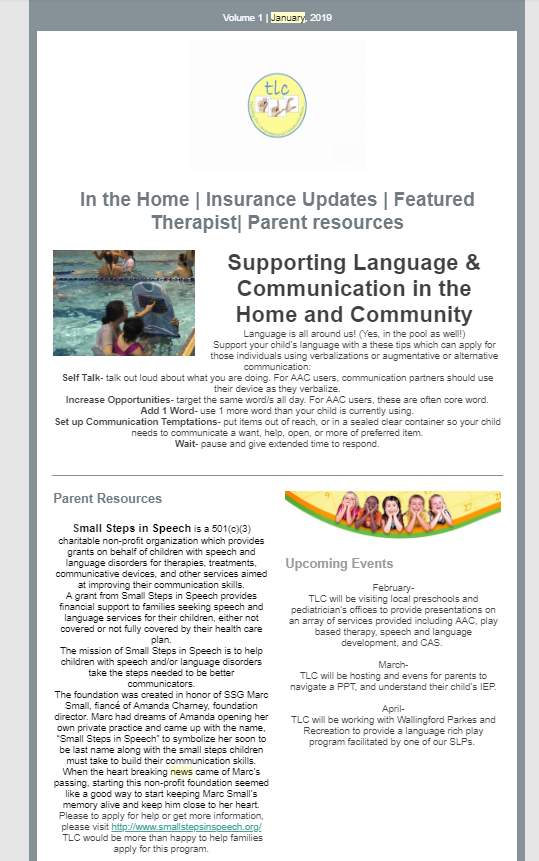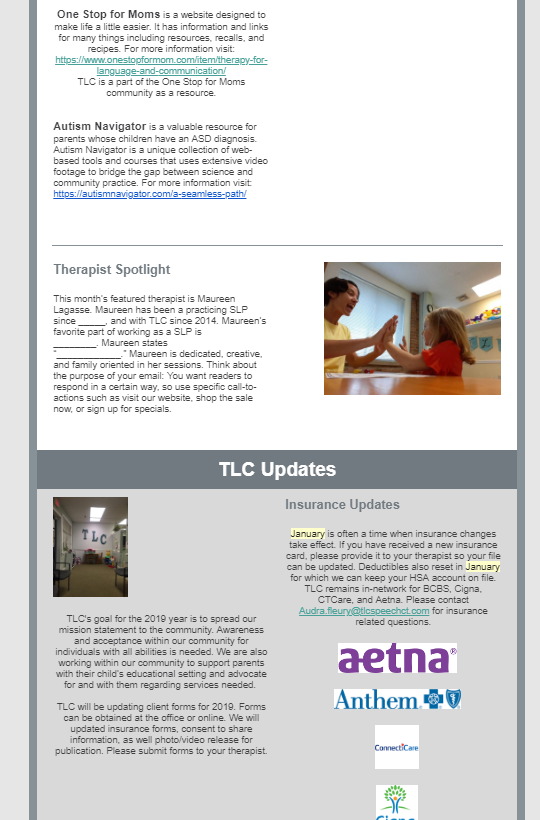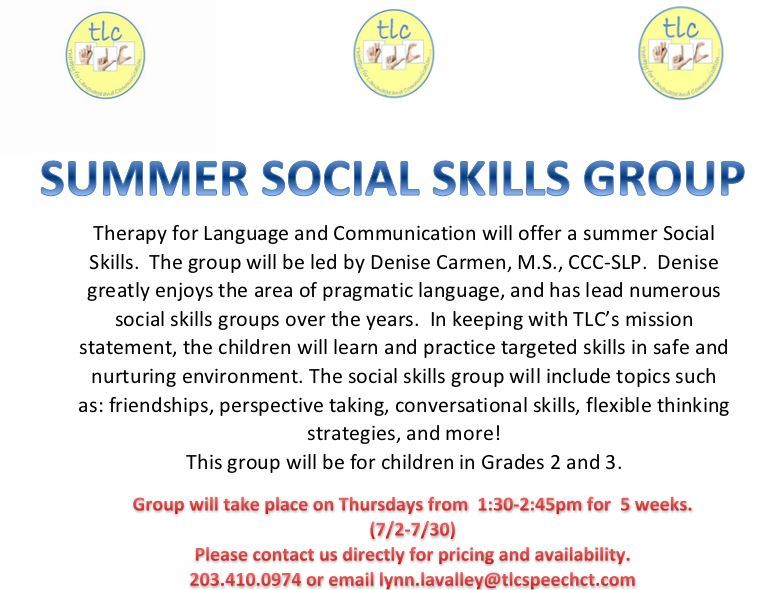Join us on Tuesday, Feb 26th at 7 pm for coffee and refreshments while Missy Barra, SLP, provides information to help you to understand the PPT process. She will help you navigate your IEP and discuss Special Education law.
TLC 5 year anniversary
TLC celebrates its 5 year anniversary! This year has brought the addition of two wonderful therapists, Carol Ann Cote’, and Missy Barra. Thank you to all the members of the TLC’s family that support us.
February 2017 Newsletter
January, 2017 was an exciting time for Therapy for Language and Communication! In January we reflected on 2016, a time when we welcomed new patients, and were proud to graduate others! TLC also celebrated its 4th year anniversary! We welcomed two new wonderful Speech-Language Pathologists, Lisa Phung and Sarah Obremski. In the fall of 2016, and in January, 2017, we continued our quest for early identification and intervention by again offering free screenings to local preschools. TLC was recognized with the 2016 Best of Wallingford award for Speech-Language Pathology. We again participated in the Autism Spectrum Resource Fair at the Oakdale Theatre to provide education and resources for our local community.
We look forward to and exciting year to come!
TLC celebrated its 3 year anniversary in August!
TLC celebrated its 3 year anniversary in August!
The fall is an exciting time for us as we are working with local organizations to host various information sessions for parents and professionals. If you are interested or have a topic you wish to discuss, please contact us.
April Newletter
March has been an exciting month for TLC with many changes. Therapy for Language and Communication is exciting to announce it will be moving locations! We will move to 300 Church Street (approximately .25 miles from its current location). TLC Speech CT will move locations on May 1, 2015! Check back for Grand Re-opening date soon… March has also been a time of stress for many families preparing for their child’s PPT. Many parents are looking for support therefore sites are listed below which may help: Connecticut Parent Advocacy Center offers support to ensure the most comprehensive PPT and IEP. – http://www.cpacinc.org/ Autism Spectrum Resource Center offers parent workshops for advocacy and PPT preparation. http://www.autismconnecticut.org/
This month TLC celebrated Dr. Suess’ birthday with literacy based activities.
News
February, 2015. This month TLC celebrated Dr. Suess’ birthday with literacy based activities. Reading to and with our children is so beneficial for their growth and development. Below is a list found at http://www.best-books-for-kids.com/benefits-of-reading.html about the benefits of reading:
1. Kids who read often get better at it. This is pretty much common sense, after all, practice makes perfect.
2. Reading exercises our brains. Reading is a much more complex task for the brain than say, watching TV is. Reading strengthens brain connections and actually builds new connections.
3. Reading improves concentration. Children have to focus on a story, and if they read or our read to regularly, they develop the ability to do this for longer periods.
4. Reading teaches children about the world around them. Through reading, children learn about people, places, and events outside their own experience. They are also exposed to ways of life, ideas and beliefs about the world which may be different from those which surround them.
5. Reading improves a child’s vocabulary and leads to more highly-developed language skills. This is because children learn new word as they read, but also because they unconsciously absorb information as they read about things like how to structure sentences and how to use words an language effectively.
6. Reading develops a child’s imagination. This is because when we read or our read to, our brains translate the descriptions we read of people, places, and things into pictures.
7. Reading helps kids develop empathy. When we are engaged in a story, we’re also imagining how the characters are feeling. We use our own experience to imagine how we would feel in the same situation.
8. Children who read do better at school.
9. Reading is a great form of entertainment.
10. Reading relaxes the body and calms the mind. When we read in silence the black and white print on a page is much less stressful for our eyes and brains.
Some of our patients’ favorites are: The Magic Tree House series, the Who Was? series, Fish Had A Wish, Brown Bear, and Good Night Moon. Happy reading!
So Many Choices, So Little Time… PART 2
By Lynn LaValley
BITSBOARD is unique app which allows its user to play 18 mini-games. At the low cost of FREE, it’s a gem! Bitsboard has a large catalog of content which was created by fellow SLPs, teachers, and/or parents. It is easy to create and customize boards, as well as share with anyone via the Bitsboard catalog. This post is the continuation from 2 weeks ago, and will review games 10-18.
Bitsboard Games are as follow:
- Word Search– the user attempts to find all the words based on the clues that are provided via pictures, audio, or full sentences. This game is highly customizable, and the programmer can specify the number of words to display. This game has “tile magnets” which can be turned off so that the user will have to release the tile above the correct answer, and the tiles will no longer snap into the correct answer tile. The programmer can also set the directions of the target words (i.e. horizontal, vertical, diagonal, etc.). As with many of the Bitsboard games, session length can be adjusted, as well as the sequence of items, and the progression of the game.
- Spelling Bee- this will assist in the acquisition of spelling, as well as navigating the keyboard. Kids are very motivated by this game because they are provided with instant feedback to correct mistakes and see checkmarks when corrected. The programmer can control setting options such as spelling order, session length (i.e. between 1 and 20 items per round),and rounds can be set as continuous play, or interrupted by a scorecard. As with all games, the sequence can be programmed to appear in alphabetical or random order, or in the order entered. The progression of the game can also be customized so that the game will automatically advance to the next screen after each correct answer, or manual so that the user has to click on the next button to advance.
- Bingo- what kid doesn’t love this game? This game allows for multiple users (up to 4 players). Settings include control over number of items and text only (which creates a reading game).
- Reader- This game helps young readers because in lue of hearing an audio prompt, the user sees a label which they have to find. (If help is needed, the user can click on the speaker icon and hear the audio stimulus.) A great feature is the adjustment of difficulty based on the user’s skill. For example, if the user gets two correct answers, the game automatically gets more difficult, but if two wrong answers are provided, the game gets easier by showing less photos. Image numbers and audio hints are all customizable, as well as session length and the sequence of items.
- Photo Hunt- this game is similar to Bingo. The user has one chance to find the correct answer. The programmer can set the maximum number of images to display, as well as turn on or off the text only setting.
- Story Time- creates stories to be shared. The options include to display the page number, provide audio feedback, read to the player, or swipe to advance. Furthermore, the sequence of information can be set as alphabetical, random, or in the order entered.
- Side by Side- this game presents two cards side by side, which makes it great for teaching concepts (e.g. opposites). This allows for the programmer to display either both text and images, or two images per page. Again, the sequence of items presented is customizable.
- Odd One Out- this game has the user find the one item that does not belong as it compares bits from two boards at the same time (i.e. 3 items from one board, and 1 from another). Bitsboard recommends using boards in Collections to create the best learning experience. Audio prompts are available in this game.
- Sort It- much like Odd One Out, this game compares bits across 2-5 different boards, and the user must figure out how to sort the items. (Again, using boards in Collections is recommended.) Games with Sort It include sorting by related items, category by starting sound, and sort items by numbers. Like all games, this game is fully customizable with number of items, hints, display options, session length, sequence, and progression.
I hope you take the time to explore this app and have enjoyed this 2 part series. As I previously said, kids love this app because everything feels like a game, and SLPs love it because the possibilities are endless.







Follow Us!